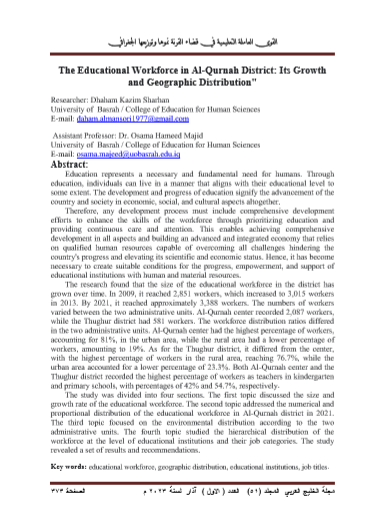The Educational Workforce in Al-Qurnah District: Its Growth and Geographic Distribution
Keywords:
educational workforce, geographic distribution, educational institutions, job titlesAbstract
Education represents a necessary and fundamental need for humans. Through education, individuals can live in a manner that aligns with their educational level to some extent. The development and progress of education signify the advancement of the country and society in economic, social, and cultural aspects altogether.
Therefore, any development process must include comprehensive development efforts to enhance the skills of the workforce through prioritizing education and providing continuous care and attention. This enables achieving comprehensive development in all aspects and building an advanced and integrated economy that relies on qualified human resources capable of overcoming all challenges hindering the country's progress and elevating its scientific and economic status. Hence, it has become necessary to create suitable conditions for the progress, empowerment, and support of educational institutions with human and material resources.
The research found that the size of the educational workforce in the district has grown over time. In 2009, it reached 2,851 workers, which increased to 3,015 workers in 2013. By 2021, it reached approximately 3,388 workers. The numbers of workers varied between the two administrative units. Al-Qurnah center recorded 2,087 workers, while the Thughur district had 581 workers. The workforce distribution ratios differed in the two administrative units. Al-Qurnah center had the highest percentage of workers, accounting for 81%, in the urban area, while the rural area had a lower percentage of workers, amounting to 19%. As for the Thughur district, it differed from the center, with the highest percentage of workers in the rural area, reaching 76.7%, while the urban area accounted for a lower percentage of 23.3%. Both Al-Qurnah center and the Thughur district recorded the highest percentage of workers as teachers in kindergarten and primary schools, with percentages of 42% and 54.7%, respectively.
The study was divided into four sections. The first topic discussed the size and growth rate of the educational workforce. The second topic addressed the numerical and proportional distribution of the educational workforce in Al-Qurnah district in 2021. The third topic focused on the environmental distribution according to the two administrative units. The fourth topic studied the hierarchical distribution of the workforce at the level of educational institutions and their job categories. The study revealed a set of results and recommendations.




